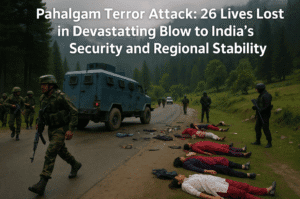Pahalgam Terror Attack: 26 Lives Lost in Devastating Blow to India’s Security and Regional Stability
The Pahalgam terror attack, which claimed 26 civilian lives in Jammu & Kashmir, has exposed fragile security gains and shattered narratives of post-Article 370 stability. Blamed on Pakistan-backed militants, the assault targeted tourists in Baisaran, crippling Kashmir’s resurgent tourism—a vital economic lifeline—and reviving fears of communal strife. India’s retaliatory measures, including diplomatic expulsions, trade suspension, and halting the Indus Waters Treaty, signal a hardened stance against Islamabad’s proxy warfare. Pakistan’s deflection tactics, such as demanding international probes, contrast starkly with its Defense Minister’s rare admission of past terror sponsorship, further isolating it globally.
While India’s security crackdowns aim to deter aggression, long-term resolution hinges on addressing Kashmir’s socio-economic fissures, bolstering intelligence networks, and rallying global consensus against state-sponsored terrorism. The attack underscores a pivotal moment: India must balance deterrence with diplomacy to dismantle Pakistan’s destabilizing playbook while healing Kashmir’s divides to forge lasting peace.

Pahalgam Terror Attack: 26 Lives Lost in Devastating Blow to India’s Security and Regional Stability
The tranquil meadows of Pahalgam, once a symbol of Kashmir’s resurgent tourism, now bear the scars of a devastating terror attack that claimed 26 civilian lives. This assault, the deadliest since the 2008 Mumbai attacks, has not only shaken India’s narrative of restored stability in Jammu and Kashmir (J&K) but also reignited urgent questions about Pakistan’s role in perpetuating cross-border terrorism. As tensions between the nuclear-armed neighbors escalate, the incident underscores a pivotal moment for India to recalibrate its strategy toward Pakistan’s destabilizing tactics.
Shattered Illusions: The Fallout of the Attack
Since the 2019 abrogation of Article 370, the Indian government has emphasized J&K’s transition toward “peace and prosperity,” citing declining militancy and a tourism boom. However, the Pahalgam attack—targeting Hindu pilgrims and tourists in the idyllic Baisaran meadows—has exposed lingering vulnerabilities. Beyond the human tragedy, the strike delivered a blow to Kashmir’s recovering economy, which saw tourist arrivals rise from 2.67 million in 2022 to nearly 3 million in 2024. The region’s tourism sector, a lifeline for local livelihoods, now faces renewed uncertainty, echoing the 1990s exodus of Kashmiri Pandits and the cyclical trauma inflicted on minority communities.
Pakistan’s Proxy War: A Pattern of Denial and Deceit
While the Resistance Front (TRF), a shadowy militant group, initially claimed responsibility before retracting, Indian intelligence points to Pakistan’s Inter-Services Intelligence (ISI) as the architect of such attacks. Islamabad’s call for an “international investigation” into Pahalgam mirrors past tactics to deflect blame, even as its Defense Minister Khawaja Asif recently acknowledged Pakistan’s history of sponsoring terrorism at the West’s behest. This rare admission, though framed as a critique of U.S. policy, inadvertently validates India’s long-standing accusations of Pakistan’s “dirty war” in Kashmir.
India’s Retaliation: Diplomatic, Economic, and Strategic Shifts
In response, India has adopted a multi-pronged approach:
- Diplomatic Measures: Expelling Pakistani diplomats and suspending visa services.
- Economic Pressure: Halting bilateral trade and tightening controls at the Attari border.
- Resource Leverage: Suspending the Indus Waters Treaty (IWT), a move that could escalate water disputes.
- Security Mobilization: Reinforcing counterterror operations along the Line of Control (LoC).
These steps signal a departure from India’s earlier restraint, reflecting a consensus within its security establishment that punitive actions must outweigh Pakistan’s capacity to inflict harm.
Global Implications and Pakistan’s Isolation
Pakistan’s credibility on the global stage has dwindled, with its admission of past terror links further alienating allies. The Financial Action Task Force (FATF)’s previous greylisting of Pakistan for terror financing, coupled with its struggling economy, amplifies its isolation. Meanwhile, India’s stance has garnered tacit support from nations affected by Islamist extremism, though China’s continued backing of Pakistan complicates the geopolitical calculus.
The Road Ahead: Beyond Symbolic Gestures
For India, the challenge lies in crafting a sustainable strategy that transcends reactive measures. Experts suggest:
- Intelligence Overhaul: Strengthening grassroots intelligence networks to preempt attacks.
- Community Engagement: Addressing local grievances in J&K to undercut radicalization.
- Global Advocacy: Lobbying to designate Pakistan as a state sponsor of terrorism.
- Economic Resilience: Insulating Kashmir’s economy through targeted investments and crisis-proof tourism frameworks.
As historian and security analyst Ajai Sahni notes, “Pakistan’s reliance on non-state actors is a crumbling strategy. India’s response must balance deterrence with diplomacy, ensuring its actions resonate globally as legitimate defense, not aggression.”
Conclusion
The Pahalgam attack is more than a tragedy—it is a catalyst for India to confront Pakistan’s proxy warfare with unprecedented resolve. While military and economic measures are necessary, lasting peace will require addressing Kashmir’s socio-political fissures and rallying international consensus against state-sponsored terrorism. In this defining moment, India’s ability to harmonize strength with statesmanship will determine whether it can finally silence the drums of conflict along its restive borders.
You must be logged in to post a comment.